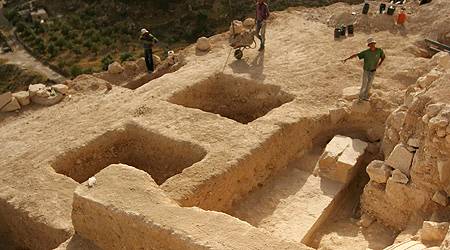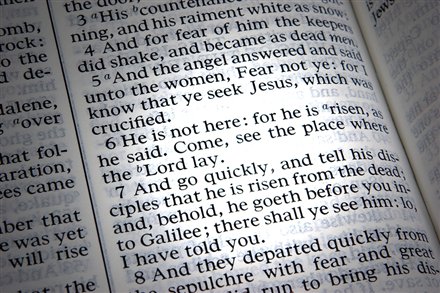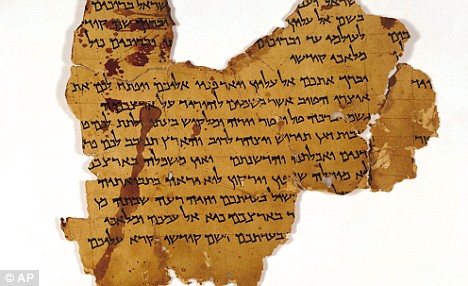Evreii au descoperit un Mesia înainte de Isus . The ancient scripts that predate – and might rewrite – the Bible
iulie 7, 2008 · 8 Comentarii
Placa, descoperită în apropierea Mării Moarte şi asemănătoare, de altfel, Manuscriselor de la Marea Moartă, este un exemplu rar de manuscris: textul înscris, şi nu gravat, cu cerneală din acea epocă, pe două coloane, similare cu cele din Tora. O parte din text s-a pierdut însă, lăsând astfel o mare parte din semnificaţiile ei deschise dezbaterii. Cu toate acestea, autenticitatea ei nu a fost pusă la îndoială până acum de nici un specialist, din contră, atât experţii în limbi ebraice, cât şi chimiştii şi arheologii care au analizat-o au ajuns la concluzia că este reală.
O mare parte din textul ei vorbeşte despre viziunea Apocalipsei prin ochii arhanghelului Gabriel. Expresia „Aşa a spus Dumnezeul Israelului“ apare de multe ori, precum şi numele Ierusalimului. Ceea ce surprinde cel mai mult însă este povestea unui salvator care a înviat după trei zile.
Chiar dacă a ajuns recent în atenţia publică, manuscrisul a fost găsit acum zece ani, la un dealer de antichităţi. Un colecţionar evreu a cumpărat piatra şi a păstrat-o în casa sa din Zürich, până când a fost examinată de un specialist, acum câţiva ani. „Nu mi-am dat seama cât de importantă era până când i-am arătat-o lui Ada Yardeni, specialistă în scrierea ebraică. A fost copleşită: «Eşti în posesia unuia dintre Manuscrisele de la Marea Moartă!», mi-a spus“, îşi aminteşte David Jeselsohn, posesorul pietrei, expert şi el în antichităţi.
Yardeni susţine că piatra datează de la sfârşitul primului secol înainte de era noastră. Specialistă în scrierile ebraice, mai ales cele din perioada regelui Irod, ea a analizat-o alături de Binyamin Elitzur, cei doi publicându-şi concluziile anul trecut în „Cathedra“, o revistă de specialitate din Israel. Articolul a stârnit interesul şi celorlalţi oameni de ştiinţă, iar în prezent există deja o serie de materiale publicate pe această temă, în timp ce altele sunt programate să apară în următoarele luni.
La evaluarea chimică, realizată de Yuval Goren, profesor de arheologie la Universitatea din Tel Aviv, specializat în verificarea artefactelor antice, a reieşit că nu există nici un motiv care să pună la îndoială veridicitatea pietrei. Moshe Idel, profesor la Universitatea Ebraică, ce tocmai a publicat o carte despre Fiul Domnului, spune şi el că piatra are o semnificaţie deosebită: „E o piatră adevărată, cu un text real“.
Cel care a venit cu cele mai multe interpretări este Israel Knohl, profesor în studiul Bibliei la Universitatea Ebraică din Israel, care a scris şi o carte despre ideea suferinţei mesianice înainte de Isus, folosind pentru a-şi susţine ipoteza o serie de mărturii literare, dar şi Manuscrisele de la Marea Moartă. Teoria lui nu a zguduit însă creştinătatea aşa cum spera, în parte şi pentru că nu avea nici o dovadă de dinaintea lui Cristos. Plăcuţa nou descoperită s-a mulat însă perfect pe ipotezele acestuia.
Ipoteza profesorului se înscrie într-o tendinţă care ia amploare printre specialişti, aceştia încercând să arate că spiritul mesianic din epoca lui Isus era explicat de atmosfera politică a acelor vremuri. În interpretarea acestuia, figura mesianică de pe placă ar putea fi a unui om numit Simon, care a fost omorât de un comandant din armata lui Irod.
Uciderea lui Simon era văzută ca un pas necesar înspre salvarea naţională, mai spune Israel Knohl, arătând pentru asta rândurile de la 19 la 21 ale manuscrisului: „În trei zile vei şti că răul va fi învins de justiţie“, precum şi alte pasaje în care se sugerează că sângele constituie drumul spre salvare. Analiza cercetătorului se bazează în principal pe descifrarea rândului 80, unde apar cuvintele „în cele trei zile“, urmate de un termen pe jumătate şters, care, în opinia profesorului Knohl, provine de la verbul „a trăi“.
Imaginea unui Mesia în suferinţă este complet diferită de cea evreiască asupra salvatorului, care apare în mod tradiţional triumfător, descendent al regelui David, recunoaşte profesorul. „Ar trebui să ne zguduie perspectiva asupra creştinătăţii“, susţine el: „Învierea după trei zile devine un motiv precreştin, în contradicţie cu toate teoriile de până acum.
Ceea ce se întâmplă în Noul Testament a fost adoptat de Isus şi de urmaşii săi pe baza unei poveşti mesianice mai vechi“. „Textul ar putea reprezenta veriga lipsă dintre iudaism şi creştinism, în măsura în care acesta înscrie credinţa creştină în învierea Mântuitorului în tradiţia ebraică“, a mai precizat profesorul de studii biblice, citat de AFP.
Moshe Bar-Asher, preşedintele Academiei de limbi ebraice şi profesor la Universitatea Ebraică, spune că a analizat mult timp textul şi îl consideră autentic, datându-l nu mai târziu de primul secol înainte de era noastră. În ceea ce priveşte teza lui Knohl, însă, Bar-Asher este precaut: „E o problemă. În părţile-cheie ale scrierii lipseşte textul. Înţeleg tendinţa lui Knohl de a găsi simboluri precreştine, dar în două din trei rânduri lipsesc multe cuvinte“.
Manuscrisul ar putea şoca creştinitatea, cu atât mai mult cu cât este o provocare adusă credinţei ei, în timp ce alţii ar putea fi încântaţi de idee, crede Daniel Boyarin, profesor în cultura talmudică la Universitatea Berkeley din California, adăugând că piatra aduce încă un argument, alături de multe altele care au apărut recent şi care sugerează că Isus ar putea fi înţeles mai bine prin istoria evreilor din timpul lui.
Teologii creştini sunt de părere că piatra nu ar putea dilua în nici un fel importanţa învierii lui Isus, scrie „Daily Mail“, şi cu atât mai puţin să demonstreze că scrierile biblice ar fi fost create pe baza ei.
61 de ani de controverse
Toate artefactele din vremea lui Cristos au fost înconjurate de controverse: au trecut 61 de ani de la descoperirea primelor Manuscrise de la Marea Moartă şi ele continuă să producă tensiuni printre oamenii de ştiinţă.
Acestea sunt singurele copii ale scrierilor biblice datate înainte de era noastră şi conţin, alături de învăţăturile religioase, şi o seamă de practici ale sectelor evreieşti din acea vreme.
Specialistul susţine că răstignirea şi învierea lui Cristos nu ar fi fost un parcurs unic, ci urmarea unei tradiţii mesianice evreieşti.
A fresh interpretation of a stone tablet dated to the decades before Jesus’s birth could undermine some fundamentals of the Christian faith, experts claim.
The tablet, which is similar in style to the Dead Sea Scrolls, is said to predict that a messiah would rise from the dead within three days.
The partially-deciphered Ancient Hebrew text had seemed to contain a vision of the apocalypse as told by the Angel Gabriel. -
A fragment of the Dead Sea Scrolls which set the word talking when they were discovered 60 years ago. The new text seems to imply the life and death of Jesus was predicted before his birth
But a leading scholar says it confirms his theory that some Jewish sects before Christ believed a messiah would save them - but not before he was killed and brought back to life after three days.
Israel Knohl, Professor of Biblical Studies at the Hebrew University of Jerusalem, says one line of the text tells the ‘prince of princes’ slain by the evil government, ‘in three days you shall live’.
He suggests the story refers to the death of a Jewish prince called Simon who led a revolt against King Herod.
Daniel Boyarin, of the University of California at Berkeley, said that there was growing evidence suggesting that Jesus could be best understood through a close reading of the Jewish history of his day.
‘Some Christians will find it shocking - a challenge to the uniqueness of their theology, while others will be comforted by the idea of it being a traditional part of Judaism,’ he said.
But Christian scholars dispute any contention that the tablet, which is in a private collection, could dilute the significance of Jesus’s resurrection.
Ben Witherington, of Asbury Theological Seminary in Wilmore, Kentucky, said: ‘This stone certainly does not demonstrate that the Gospel passion stories are created on the basis of this stone text.’
Sursa Dailymail
The first mention of the “slain Messiah” called Mashiah ben Yosef (Messiah Son of Joseph) is in the Talmud (Sukkah 52a). In my book “The Messiah Before Jesus” (University of California Press, 2000), I argue that the story of this slain messiah is based on historical fact. I believe it is connected to the Jewish revolt in the Land of Israel following the death of King Herod in 4 B.C.E. This Jewish insurrection was brutally suppressed by the armies of Herod and the Roman emperor Augustus, and the messianic leaders of the revolt were killed. These events set the slain Messiah Son of Joseph tradition into motion and paved the way for the emergence of the concept of “catastrophic messianism.” Interpretations of biblical text helped to shape the belief that the death of the messiah was a necessary and indivisible component of salvation. My conclusion, based on apocalyptic writings dating to this period, was that certain groups believed the messiah would die, be resurrected in three days, and ascend to heaven (see “The Messiah Before Jesus,” 27-42).
Ada Yardeni and Binyamin Elitzur recently published the text of a fascinating text they call “Hazon Gabriel” or the Gabriel Revelation (Cathedra magazine, vol. 123). This text, engraved in stone, conveys the apocalyptic vision of the Archangel Gabriel. Yardeni and Elitzur date it by its linguistic features and the shape of the letters to the end of the first century B.C.E.
In lines 16-17 of the text, God addresses David as follows: “Avdi David bakesh min lifnei Efraim” (”My servant David, ask Ephraim”). In the Bible, Ephraim is the son of Joseph. This sets up an equivalence between David and Ephraim and the Talmudic “Mashiah ben David” and “Messiah Son of Joseph,” and confirms my theory that the Messiah Son of Joseph was already a known figure at the end of the first century B.C.E.
Advertisement
Although Yardeni and Elitzur offer a fine reading of the text, in my opinion one of the most important words has not been properly deciphered. Line 80 begins with the phrase “Leshloshet yamin” (”In three days”), followed by another word that the editors could not read. Then comes the phrase “Ani Gavriel” (”I, Gabriel”). I believe that this “illegible” word is actually legible. It is the word “hayeh” (live), and that Gabriel the Archangel is giving orders to someone: “Leshloshet yamin hayeh” (”In three days, you shall live”). In other words, in three days, you shall return to life (compare “bedamaiyikh ha’ee” – translated as “in thy blood live” – in Ezekiel 16:6). The word “haye” (live) is written here with alef. Similar orthography appears in the Dead Sea Scrolls, for example in the Isaiah scroll, where the word “yakeh” (30:31) is written with an alef after the yod.
This is followed by traces of two more words. The letters are not easy to make out, but the first word seems to begin with a gimmel and vav. The next word is not clear either. The letter lamed is quite legible, and the letter before it seems to be an ayin. I believe the sentence can be reconstructed as follows: “Leshloshet yamin hayeh, ani Gavriel, gozer alekha” (”In three days, live, I, Gabriel, command you”). The archangel is ordering someone to rise from the dead within three days. To whom is he speaking?
Who is the ‘prince of princes’?
The answer appears in the following line, Line 81: “Sar hasarin” (”Prince of Princes”). The sentence reads: “Leshloshet yamin khayeh, ani Gavriel, gozer alekha, sar hasarin” (In three days, I, Gabriel, command you, prince of princes.” Who is the “prince of princes”? The primary biblical source for the Gabriel Revelation is the narrative in the Book of Daniel (8:15-26), in which the Archangel Gabriel reveals himself to Daniel for the first time. Gabriel describes a “king of fierce countenance.” This king “shall destroy them that are mighty and the people of the saints… he shall also stand up against the prince of princes” (Daniel 8:24-25).
The author of the Gabriel Revelation seems to be interpreting the biblical narrative as follows: An evil king arises and virtually destroys the Jewish people, the “people of the saints.” He even manages to overcome and slay their leader, the “prince of princes.” This is the leader who will be resurrected in three days.
Was the prince of princes a historical figure? I believe he was. The key to identifying him lies in the phrase “arubot tzurim,” which comes after the reference to the prince of princes. In the Bible and Talmud, the word “aruba” means a narrow opening or slit. “Tzurim” are rocks (the word appears here in an unvocalized form, without theletter vav). “Arubot tzurim” would thus be a crevice. The death of the prince of princes is somehow associated with a rocky crevice.
The Gabriel Revelation, as we have said, has been dated, on the basis of linguistics and orthography, to the end of the first century BCE. The circumstances surrounding the discovery of the inscription are unknown. All we are told by the editors is that it may have been discovered in Transjordan. This leads us to Transjordan in the late first century BCE. Do we know of any Jewish leader or king who was killed here in antiquity and whose death has some sort of connection to a rocky gorge?
The revolt in 4 BCE was a bid for freedom. The rebels sought to throw off the yoke of the Herodian monarchy, which enjoyed the support of the Romans. The insurrection, which began in Jerusalem and spread throughout the country, had several leaders. A study of both Jewish and Roman sources shows that the most prominent of them was Simon, who operated from Transjordan. Simon declared himself king, wore a crown, and was perceived as king by his followers, who hung messianic hopes on him.
This is how the first century Jewish historian Josephus describes Simon’s death in battle: “Simon himself, endeavoring to escape up a steep ravine, was intercepted by Gratus [a commander in Herod's army], who struck the fugitive from the side with a blow on the neck, which severed his head from his body.” With its reference to a rocky crevice and the prince of princes, the text seems to be alluding to the death of Simon, the rebel leader who was crowned king, in a narrow gorge in Transjordan.
Chariot to heaven
But the Gabriel Revelation also mentions other deaths. In Line 57, we find the phrase “dam tvuhey yerushalayim” (”the blood of the slain of Jerusalem”). Line 67 reads: “Baser lo al dam zu hamerkava shelahen” (”Tell him about the blood. This is their merkava [heavenly chariot]“). The message being conveyed is that the blood of those who were killed will become their “chariot” to heaven.
Hovering in the background, of course, is the story of Elijah’s ascent to heaven: “Behold, there appeared a chariot of fire, and horses of fire… and Elijah went up in a whirlwind into heaven” (II Kings 2:11).
Simon, the prince of princes, was the messianic leader of a group active in Transjordan. The Gabriel Revelation appears, therefore, to have been written by his followers, and reflects an attempt to cope with the failure of the revolt and the death of their leader, recalling verses from the Book of Daniel that incorporate the words of the archangel.
The “king of fierce countenance” is identified as the Roman emperor Augustus, whose army brutally suppressed the revolt. Simon, the rebel leader anointed king, is identified as the prince of princes. The slaying of Simon by the supporters of the evil king is perceived as a fulfillment of Gabriel’s vision. After all, Gabriel prophesied that the king of fierce countenance would defeat the prince of princes. “But he shall be broken without hand,” the verse continues. The implication is that with the death of the messianic leader, their troubles are coming to an end: The fall of the enemy and salvation are near. “Leshloshet yamin tayda ki-nishbar hara melifnay hatzedek” (”In three days you will know that evil will be defeated by justice”), we read in lines 19-21.
If the Gabriel Revelation dates to the end of the first century BCE, as we have stated, then during this period, which was close in time to the birth of Jesus, there were people who believed that the death of the messiah was an integral part of the salvation process. It became an article of faith that the slain messianic leader would be resurrected within three days, and rise to heaven in a chariot.
The Gabriel Revelation thus confirms my thesis that the belief in a salin and resurrected messiah existed prior to the messianic activity of Jesus. The publication of this text is extraordinarily important. It is a discovery that calls for a complete reassessment of all previous scholarship on the subject of messianism, Jewish and Christian alike.
Israel Knohl is Yehezkel Kaufmann Professor of Biblical Studies at the Hebrew University of Jerusalem and a senior research fellow at the Shalom Hartman Institute
International Herald Tribune




















.jpg)




















1 comments:
A fé cristã não será e nem foi abalada pelo contrário será fortalecida pois a comunidade judaica sempre falou que a visão do Messias morrer e depois ressuscitar era uma invenção cristã e vemos neste achado arqueológico o contrário. Quanto a um Messias que morre Isaías 53 é claro quanto ao sofrimento e morte do servo sofredor (Rabino Mosheh alshir)
Post a Comment